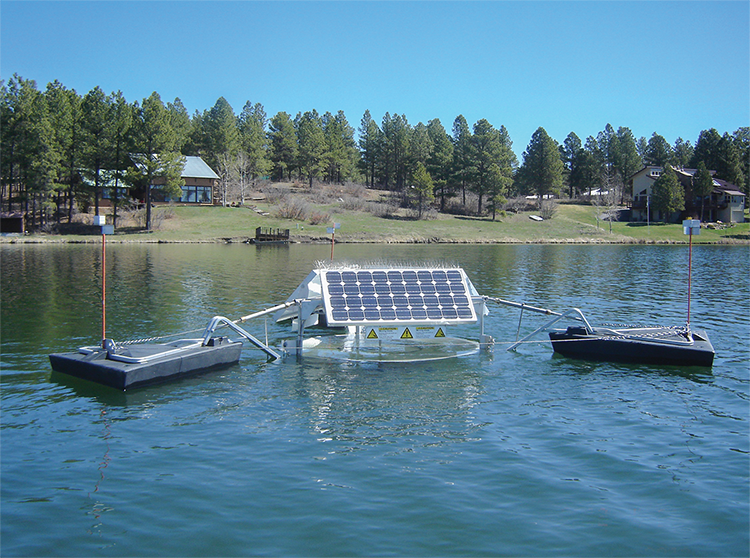In The Mix E-Newsletter- May / June 2019
 As summer nears and warm weather sets in, lakes, reservoirs, and ponds across the United States and Canada will begin to experience cyanobacteria (blue-green algae) blooms. For this issue of our In The Mix E-Newsletter, we compiled some useful learning and reference materials to help you better understand your lake and how active circulation can help fight against harmful algal blooms. Please feel free to contact us anytime to discuss your particular project.
As summer nears and warm weather sets in, lakes, reservoirs, and ponds across the United States and Canada will begin to experience cyanobacteria (blue-green algae) blooms. For this issue of our In The Mix E-Newsletter, we compiled some useful learning and reference materials to help you better understand your lake and how active circulation can help fight against harmful algal blooms. Please feel free to contact us anytime to discuss your particular project.
In This Issue
• Lakes A To Z Help Guide
• Seasonal Changes In Lakes Primer
• Featured Case Study- Cyanobacteria Control In A Raw Water Lake
• Video- How Does SolarBee® Circulate A Lake?
• Video- How Does SolarBee® Control Cyanobacteria?
• Video- What Is An AerationPlus© Lake & Pond Circulator?
Download Our Water Quality Solutions Brochure to learn how Medora can help improve all your water!
 Learn the "A to Z" About Your Lake.
Learn the "A to Z" About Your Lake.
Medora's new "Lakes A to Z Help Guide" is now available!
 Medora Corporation has compiled a new reference guide to help you better understand lake vocabulary, processes and treatment options in laymen's terms.
Medora Corporation has compiled a new reference guide to help you better understand lake vocabulary, processes and treatment options in laymen's terms.
Medora's lake knowledge is not only based on study, but also on real-world, on-the-water field work. We think this guide will prove to be a useful resource for lake & pond stakeholders as they work to maintain and improve their water quality. If you would like to see terms corrected, improved, added or if you have other recommendations how to make this a more valuable reference, please feel free to contact us any time! (Access It Here)
 Seasonal Changes In Lakes Primer
Seasonal Changes In Lakes Primer
 Another new addition to our "lakes library" is our Seasonal Changes In Lakes Primer. This will give you a very quick overview of lake behavior in the northern United States over the course of the four seasons. For lakes in the warmer, southern regions of the U.S. that don't experience winter ice over, the other three seasons spread out over more months to give these lakes a repeating cycle too. (Access It Here)
Another new addition to our "lakes library" is our Seasonal Changes In Lakes Primer. This will give you a very quick overview of lake behavior in the northern United States over the course of the four seasons. For lakes in the warmer, southern regions of the U.S. that don't experience winter ice over, the other three seasons spread out over more months to give these lakes a repeating cycle too. (Access It Here)
 Featured Case Study- Cyanobacteria & Odor Control In A Raw Water Lake
Featured Case Study- Cyanobacteria & Odor Control In A Raw Water Lake
This reservoir experienced water quality issues associated with cyanobacteria blooms (also known as blue-green algae). Cyanobacteria can contribute to taste & odor problems in drinking water and is potentially toxic to fish & wildlife.
Environmentalists have identified an emerging neurological problem with certain bird species. They speculate cyanotoxins emitted by certain cyanobacteria species are the likely cause. High levels of these cyanotoxins have been verified in the lake during certain time periods.
To help keep their water supply as safe as possible, the County previously used chemicals to control the cyanobacteria proliferation; however, increasing costs for these chemicals led county leaders to research new options. In early 2013, the Georgia Environmental Finance Authority approved nancing for the SolarBee® project. (Read More)
 Video White Board- How Does A SolarBee Circulate A Lake?
Video White Board- How Does A SolarBee Circulate A Lake?
Looking for more videos? Check out our Video Resource Library!
 Video White Board- How Does A SolarBee Control Cyanobacteria?
Video White Board- How Does A SolarBee Control Cyanobacteria?


